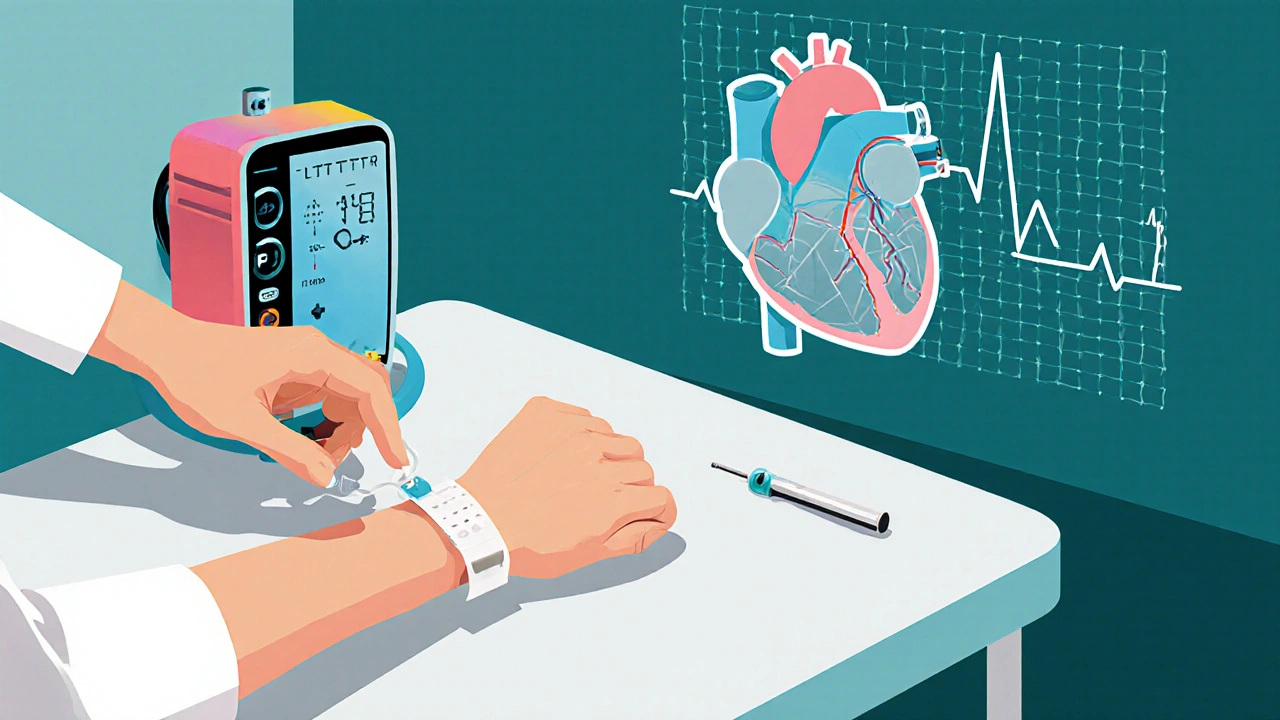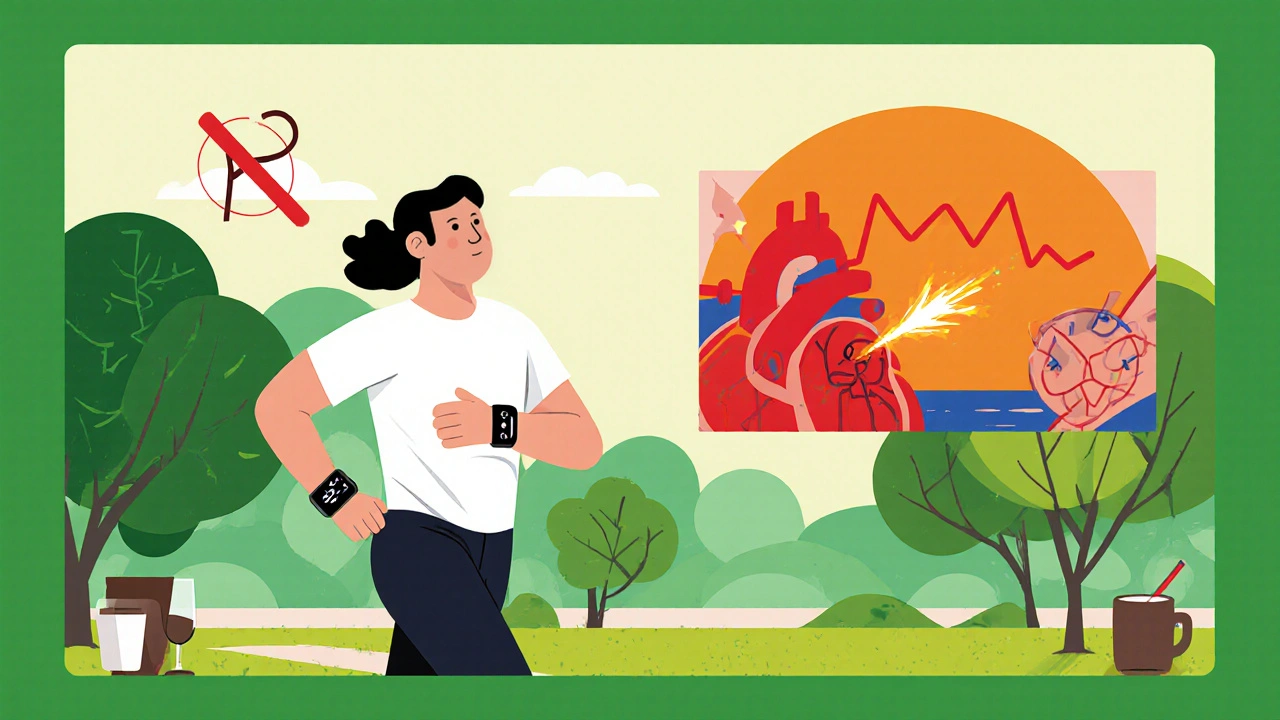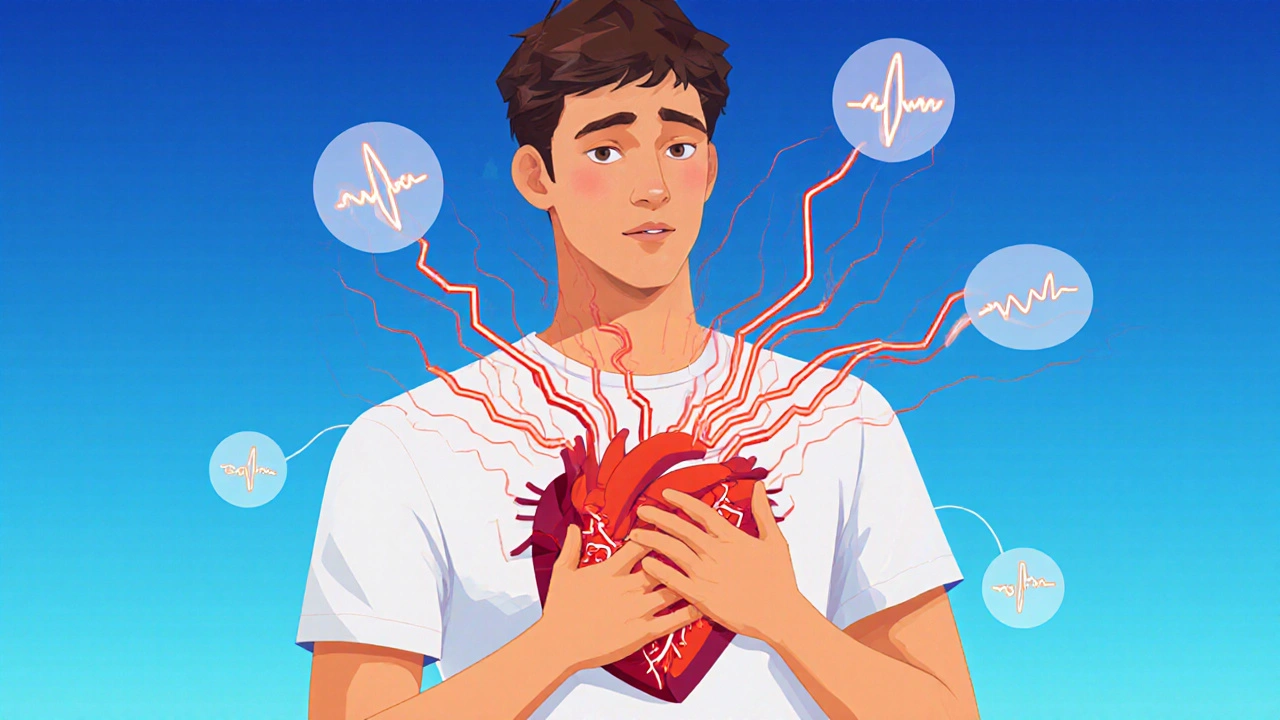SVT Symptom Assessment Tool
Check if your symptoms align with supraventricular tachycardia (SVT) and get guidance on next steps.
Symptom Checklist
Select symptoms you're experiencing:
Results: This assessment suggests possible SVT symptoms.
Next steps: Monitor symptoms closely. If symptoms persist for more than 5 minutes or you experience chest pain, seek emergency medical help immediately.
When your heart suddenly races to 150‑250 beats per minute, it can feel like a panic attack you didn’t sign up for. That rapid pulse is often supraventricular tachycardia, a common heart‑rhythm disorder that most patients can manage with the right knowledge.
Key Takeaways
- SVT is a fast heart rhythm that starts above the ventricles and is usually not life‑threatening.
- Typical symptoms include palpitations, dizziness, shortness of breath, and chest discomfort.
- Diagnosis relies on ECG, Holter monitoring, and sometimes an electrophysiology study.
- Acute treatment options range from simple vagal maneuvers to medication (adenosine, beta blockers) and catheter ablation.
- Long‑term management focuses on trigger avoidance, regular follow‑up, and lifestyle adjustments.
What Is Supraventricular Tachycardia?
Supraventricular Tachycardia is a rapid heart rhythm that originates above the heart's ventricles, typically between 150 and 250 beats per minute. It occurs when electrical signals in the atria or the atrioventricular (AV) conduction system fire faster than normal. While the episode can be alarming, most forms are benign and respond well to treatment.
How the Heart’s Electrical System Gets Out of Sync
The heart’s beat is coordinated by a tiny electrical highway. Impulses start in the Atrioventricular node, pause briefly, then travel to the ventricles. In SVT, an extra circuit-often a re‑entry loop-makes the signal race around the conduction pathway, causing the atria and ventricles to fire together at a high rate.
Common Types of SVT
Not all SVT episodes are created equal. Understanding the subtype helps doctors tailor treatment.
| Subtype | Typical Circuit | Most Effective Long‑Term Treatment |
|---|---|---|
| AV nodal reentrant tachycardia (AVNRT) | Re‑entry within the AV node itself. | Catheter ablation of the slow pathway. |
| AV reciprocating tachycardia (AVRT) | Uses an accessory pathway (often seen in Wolff‑Parkinson‑White syndrome). | Ablation of the accessory pathway. |
| Atrial tachycardia | Focal point in the atrial tissue. | Anti‑arrhythmic drugs or ablation of the focus. |
| Wolff‑Parkinson‑White (WPW) syndrome | Extra conductive tissue (bundle of Kent) connecting atria and ventricles. | Accessory pathway ablation; sometimes medication. |

Signs and Symptoms to Watch For
SVT can feel like a sudden sprint of the heart. Common clues include:
- Palpitations - a sensation of fluttering or racing.
- Dizziness or light‑headedness, especially when standing.
- Shortness of breath, even at rest.
- Chest tightness or mild pain.
- Feeling unusually anxious or fatigued after an episode.
If an episode lasts longer than a few minutes, or you experience fainting, chest pressure, or shortness of breath that worsens, call emergency services immediately.
When to Seek Medical Help
Most SVT episodes resolve on their own, but you should see a doctor if:
- Episodes occur more than once a month.
- Symptoms interfere with daily activities or sleep.
- you have underlying heart disease, high blood pressure, or diabetes.
- you notice a rapid heartbeat that does not stop after a few minutes of self‑care.
How Doctors Diagnose SVT
The first step is a 12‑lead electrocardiogram (ECG) performed during an episode. If the episode is brief, doctors may use a:
- Holter monitor - a portable device worn for 24‑48 hours that records heart rhythm continuously.
- Event recorder - a device patients activate when they feel symptoms.
- Electrophysiology study - an invasive test where catheters map the heart’s electrical pathways to pinpoint the exact circuit.

Acute Management: Stopping an Episode
When you feel an SVT start, try these first‑line, doctor‑approved maneuvers:
- Valsalva maneuver - bear down as if having a bowel movement for 15 seconds.
- Cold water face immersion - splash cold water on your face or press an ice pack to your forehead.
- Carotid sinus massage - only under professional guidance, as it can be risky for some patients.
If vagal tricks don’t work, emergency providers often give a rapid IV dose of adenosine, which briefly blocks the AV node and can reset the rhythm.
Long‑Term Treatment Options
When episodes are frequent, doctors discuss medication, procedural, and lifestyle strategies.
Medications
- Beta blocker (e.g., propranolol, metoprolol) - slows heart rate and blocks sympathetic triggers.
- Calcium‑channel blockers (verapamil, diltiazem) - help especially in AVNRT.
- Anti‑arrhythmic drugs (flecainide, propafenone) - reserved for refractory cases.
Catheter Ablation
This minimally invasive procedure uses radiofrequency energy to destroy the tiny tissue responsible for the re‑entry circuit. Success rates exceed 95 % for AVNRT and 85‑90 % for AVRT. Recovery is typically a few days, and many patients are medication‑free afterward.
Lifestyle Modifications
- Avoid caffeine, alcohol, and nicotine - these can lower the threshold for an episode.
- Manage stress through meditation, yoga, or regular exercise.
- Maintain a healthy weight; obesity increases sympathetic tone.
- Keep a symptom diary - noting triggers helps tailor future therapy.
Living With SVT: Practical Tips
Even after successful treatment, staying proactive matters.
- Carry a small card with your diagnosis and emergency contacts.
- If you’ve been prescribed a rescue medication (e.g., a nitrate or adenosine kit), keep it accessible.
- Schedule routine follow‑ups with a cardiologist or electrophysiologist every 6‑12 months.
- Consider a wearable heart monitor (like an Apple Watch) that alerts you to high rates.
Frequently Asked Questions
Can SVT lead to a heart attack?
SVT itself does not cause a myocardial infarction. However, prolonged rapid rates can strain the heart, especially in people with existing coronary disease, so prompt treatment is still important.
Is surgery ever needed for SVT?
Surgery is rare. Catheter ablation, which uses catheters inserted through a vein, is the standard curative approach. Open‑heart surgery is reserved for very complex, refractory cases.
Can children have SVT?
Yes. Pediatric SVT often presents as a rapid heartbeat during fever or excitement. Treatment principles are similar, but dosing of medications is weight‑based.
Do I need a pacemaker if I have SVT?
A pacemaker is usually not required for SVT. It may be considered only if a patient develops bradycardia after ablation or has a separate conduction disorder.
How often should I see my cardiologist?
If you’re stable on medication, an annual review is typical. After an ablation, the first follow‑up is usually 3‑months post‑procedure, then yearly if you’re symptom‑free.
Understanding SVT empowers you to act quickly, work with your healthcare team, and keep your heart rhythm in check. With the right mix of self‑care, medication, and possibly a one‑time ablation, most patients return to normal activity without fearing the next episode.


bill bevilacqua
Well, another “comprehensive” guide that probably scares people more than it helps!!!